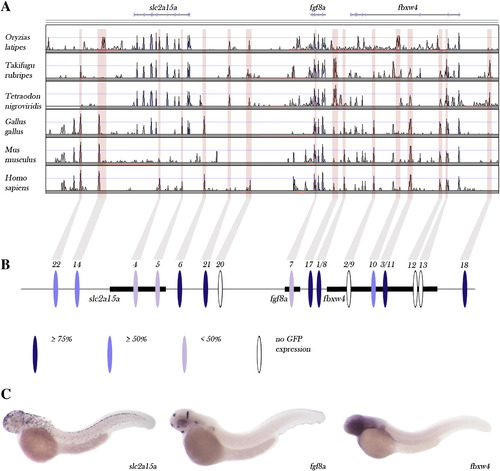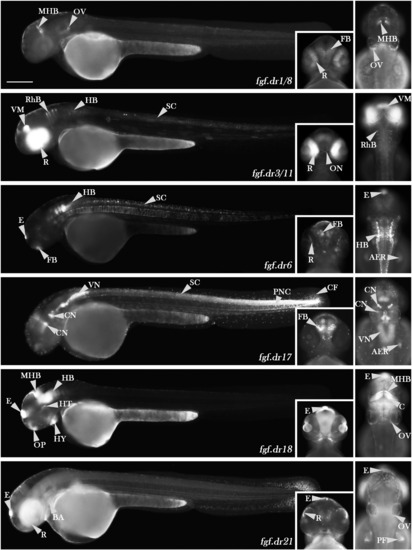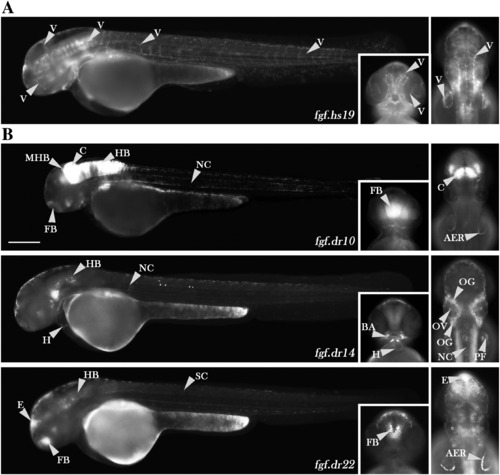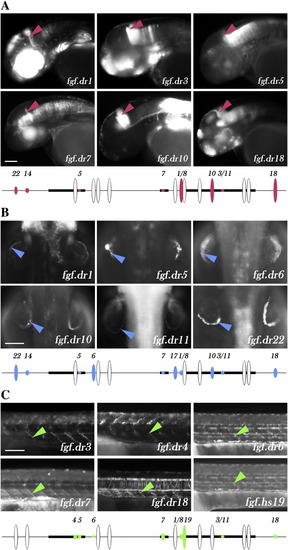- Title
-
Cis-regulation and chromosomal rearrangement of the fgf8 locus after the Teleost/tetrapod split
- Authors
- Komisarczuk, A.Z., Kawakami, K., and Becker, T.S.
- Source
- Full text @ Dev. Biol.
|
Overview of regulatory sequences tested in the zebrafish fgf8a locus. (A) Vista plot of zebrafish (as the base genome) with multiple vertebrate genomes, names on the left. Boxed elements correspond to the oval elements in B. The black bars indicate genes and the ovals the tested CNEs. White ovals indicate elements that did not exhibit enhancer activity. The intensity of blue ovals shows various levels of regulatory specificity of CNEs: navy blue—highly specific, reproducible elements (at least 75% of transgenic lines shown the same pattern); medium blue—elements which show a main, specific pattern with extra variable domains (more than 50% reproducibility); purple—elements which drove variable expression pattern with less than 50% reproducibility. (C) In situ hybridization patterns of zebrafish fgf8a and the two adjacent bystander genes slc2a15a and fbxw4 at day 2 of development. Substantial differences can be noticed in the expression pattern of these genes: specific and highly restricted expression of fgf8a, ubiquitously expressed fbxw4 and skin expression of slc2a15a. Anterior is to the left. EXPRESSION / LABELING:
|
|
Reporter gene expression patterns directed by six elements. Element fgf.dr1/8 is active in the midbrain–hindbrain boundary, forebrain, otic vesicle and retina. Element fgf.dr3/11 drove expression in the retina, optic nuclei, ventral midbrain spinal cord and in the rhombomeres. Element fgf.dr6 showed activity in the epiphysis, hindbrain, forebrain, retina, apical ectodermal ridge and spinal cord. Element fgf.dr17 drove GFP expression in cranial motor neurons, vagal nerve, in the hindbrain, apical ectodermal ridge, in the posterior spinal cord and posterior notochord and strongly in the tailbud and caudal fin. Element fgf.dr18 drove expression in all anterior fgf8a expressing structures: in the midbrain–hindbrain boundary, cerebellum, epiphysis, hypothalamus, forebrain, hindbrain, otic vesicle and hyoid cartilage. Element fgf.dr21 drove GFP expression in epiphysis, branchial arches, retina, otic vesicle and pectoral fin. Abbreviations: (AER) apical ectodermal ridge, (BA) branchial arches, (CF) caudal fin, (C) cerebellum, (CN) cranial motor neurons, (E) epiphysis, (FB) forebrain, (HB) hindbrain, (HT) hypothalamus, (HY) hyoid, (MHB) midbrain–hindbrain boundary, (OV) otic vesicle, (ON) optic nerve, (PF) pectoral fin, (PNC) posterior notochord, (R) retina, (RhB) rhombomere boundaries, (SC) spinal cord, (VM) ventral midbrain, (VN) vagal nuclei. Scale bars = 250 μm. EXPRESSION / LABELING:
|
|
Enhancers with reporter protein expression in fgf8a-specific patterns. (A) The tetrapod-specific element fgf.hs19 drove GFP expression in the vasculature in zebrafish transgenic lines. (B) Elements that showed a main specific pattern with extra variable domains. Only specific domains are indicated. Element fgf.dr10 was active in the forebrain, midbrain–hindbrain boundary, cerebellum, hindbrain, notochord and apical ectodermal ridge. Element fgf.dr14 had activity in the heart, hindbrain, notochord, branchial arches, otic vesicle, pectoral fin and otic ganglion. Element fgf.dr22 drove GFP expression in epiphysis, forebrain, hindbrain, spinal cord and apical ectodermal ridge. For abbreviations, see Fig. 3; (H) heart, (NC) notochord, (OG) otic ganglion, (V) vasculature. Scale bars = 250 μm. EXPRESSION / LABELING:
|
|
Multiple transgenes with reporter expression in signaling centers. Certain structures (A: midbrain–hindbrain boundary; B: apical ectodermal ridge; C: anterior myotomes) that fall into the expression domain of fgf8a are regulated through a set of tested fgf8a elements. Upper panel shows examples of transgenic lines from regulatory elements that directed reporter protein expression to specific structures. Lower section shows all regulatory elements that are active in particular structures. The height of ovals indicates the percentage of transgenic lines from each element that drove GFP expression in a particular structure (white oval height equals 100%). The tetrapod-specific element fgf.hs19 is indicated in the place corresponding to the human locus. (A) Midbrain–hindbrain boundary (MHB) expression is regulated by 8 elements (pink) dispersed around fgf8a: fgf.dr1/8, fgf.dr3/11, fgf.dr5, fgf.dr7, fgf.dr10, fgf.dr14, fgf.dr18 and fgf.dr22. (B) Apical ectodermal ridge (AER) expression is regulated by 10 elements (blue): fgf.dr1/8, fgf.dr3/11, fgf.dr4, fgf.dr6, fgf.dr7, fgf.dr10, fgf.dr14, fgf.dr17, fgf.dr18 and fgf.dr22. (C) Reporter expression to anterior myotome and tail tip is directed by 8 elements (green): fgf.dr1/8, fgf.dr3/11, fgf.dr4, fgf.dr5, fgf.dr6, fgf.dr7, fgf.dr18 and fgf.hs19. Scale bar = 100 μm. |
Reprinted from Developmental Biology, 336(2), Komisarczuk, A.Z., Kawakami, K., and Becker, T.S., Cis-regulation and chromosomal rearrangement of the fgf8 locus after the Teleost/tetrapod split, 301-312, Copyright (2009) with permission from Elsevier. Full text @ Dev. Biol.




